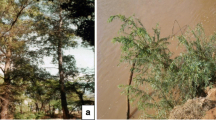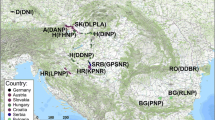Abstract
European Black Poplar (Populus nigra) is considered a rare and endangered tree species because of severe reduction of its natural riverine habitat and potential hybridisation with the related non-indigenous taxa P. deltoides and P. x canadensis. As it is difficult to distinguish these taxa solely based on their morphology, we applied a PCR-based assay with an easy-to-use and robust molecular marker set (cpDNA trnL-trnF/RsaI RFLP, nDNA win3 and nDNA POPX/MspI RFLP) in order to identify pure P. nigra. Different plant tissues could be used for fast and standardised DNA extraction. The application of the three marker types was tested on a number of different Populus taxa, and they were also used for the verification of pure P. nigra in a sample of 304 putative P. nigra individuals from Switzerland. Cross-checking of the DNA data with those using a traditional allozyme approach resulted in complete agreement. The availability of molecular identification methods is an important prerequisite for the conservation of European Black Poplar, because pure, non-introgressed plant material can then be used in restoration projects of European floodplains.

Similar content being viewed by others
References
Arens P, Coops H, Jansen J, Vosman B (1998) Molecular genetic analysis of Black Poplar (Populus nigra L.) along Dutch rivers. Mol Ecol 7:11–18
Barsoum N (2001) Regeneration – requirements and promotion measures. In: Lefèvre F, Barsoum N, Heinze B, Kajba D, Rotach P, De Vries SMG, Turok J (eds) In situ conservation of Populus nigra. IPGRI, Rome, pp 16–24
Benetka V, Mottl J, Vacková K, Pospíšková M, Dubsky M (1999) Estimation of the introgression level in Populus nigra L. populations by means of isozyme gene markers. Silvae Genet 48:218–223
Bradshaw HD Jr, Villar M, Watson BD, Otto KG, Stewart S, Stettler RF (1994) Molecular genetics of growth and development in Populus. 3. A genetic linkage map of Hybrid Poplar composed of RFLP, STS and RAPD markers. Theor Appl Genet 89:167–178
Cagelli L, Lefèvre F (1995) The conservation of Populus nigra and gene flow with cultivated poplars in Europe. Forest Genet 2:135–144
Demesure B, Sodzi N, Petit RJ (1995) A set of universal primers for amplification of polymorphic non-coding regions of mitochondrial and chloroplast DNA in plants. Mol Ecol 4:129–131
Dietiker F, Jansen E (2003) Das Sachprogramm Auenschutzpark Aargau – eine Zwischenbilanz mit Beispielen realisierter Waldprojekte im Freiamt. Schweiz Z Forstwes 7:274–280
EUFORGEN (s.d.) Populus nigra L. IPGRI, Rome
Fossati T, Grassi F, Sala F, Castiglione S (2003) Molecular analysis of natural populations of Populus nigra L. intermingled with cultivated hybrids. Mol Ecol 12:2033–2043
Heinze B (1997) A PCR marker for a Populus deltoides allele and its use in studying introgression with native European Populus nigra. Belg J Bot 129:123–130
Heinze B (1998) Molekulargenetische Unterscheidung und Identifizierung von Schwarzpappeln und Hybridpappelklonen. FBVA Ber 105:1–44
Heinze B (2001) PCR-RFLP analysis of introns of nuclear genes in Populus and Prunus. In: Müller-Starck G, Schubert R (eds) Genetic responses of forest systems to changing environmental conditions. Kluwer, Dordrecht, pp 117–127
Heinze B, De Vries SMG (1998) Integration nationaler und internationaler Generhaltungsprogramme: das EUFORGEN – Netzwerk Schwarzpappel in Österreich und den Niederlanden. In: Geburek T, Heinze B (eds) Erhaltung genetischer Ressourcen im Wald – Normen, Programme, Massnahmen. Ecomed, Landsberg, pp 178–188
Heinze B, Lefèvre F (2001) Genetic considerations for the restoration of riparian populations. In: Lefèvre F, Barsoum N, Heinze B, Kajba D, Rotach P, De Vries SMG, Turok J (eds) In situ conservation of Populus nigra. IPGRI, Rome, pp 25–35
Heinze B, Lickl E (2002) Rare, but steady, introgression in Austrian Black Poplar as a long-term risk? In: Van Dam BC, Bordács S (eds) Genetic diversity in river populations of European Black Poplar. Csiszár Nyomda, Budapest, pp 169–175
Hofmann M (2002) Economic aspects of Black Poplar – hybrids, yield and utilisation of wood. In: Van Dam BC, Bordács S (eds) Genetic diversity in river populations of European Black Poplar. Csiszár Nyomda, Budapest, pp 205–212
Imbert E, Lefèvre F (2003) Dispersal and gene flow of Populus nigra (Salicaceae) along a dynamic river system. J Ecol 91:447–456
Janssen A (1997) Unterscheidung der beiden Schwarzpappelarten Populus nigra L. und P. deltoides Marsh. sowie ihrer Arthybride P. x euramericana (Dode) Guinier mit Hilfe von Isoenzymmustern. Holzzucht 51:17–23
Kajba D, Romanić B (2002) Morphological leaf variability of the European Black Poplar (Populus nigra L.) in natural populations in the Drava river basin in Croatia. In: Van Dam BC, Bordács S (eds) Genetic diversity in river populations of European Black Poplar. Csiszár Nyomda, Budapest, pp 221–227
Lefèvre F, Kajba D, Heinze B, Rotach P, De Vries SMG, Turok J (2001) Black Poplar: a model for gene resource conservation in forest ecosystems. Forest Chron 77:139–244
Lefèvre F, Bordács S, Cotrell J, Gebhardt K, Smulders MJM, Van den Broeck A, Vornam B, Van Dam BC (2002) Recommendations for riparian ecosystem management based on the general frame defined in EUFORGEN and results from EUROPOP. In: Van Dam BC, Bordács S (eds) Genetic diversity in river populations of European Black Poplar. Csiszár Nyomda, Budapest, pp 157–161
QIAGEN (2002) DNeasy 96 plant handbook. QIAGEN, Valencia
Rajora OP (1989) Characterisation of 43 Populus nigra L. clones representing selections, cultivars and botanical varieties based on their multilocus allozyme genotypes. Euphytica 43:197–206
Rajora OP, Dancik BP (1992) Chloroplast DNA inheritance in Populus. Theor Appl Genet 84:280–285
Rajora OP, Rahman MH (2001) Microsatellite DNA markers and their usefulness in poplars and conservation of microsatellite DNA loci in Salicaceae. In: Müller-Starck G, Schubert R (eds) Genetic response of forest systems to changing environmental conditions. Kluwer, Dordrecht, pp 105–115
Rajora OP, Rahman MH (2003) Microsatellite DNA and RAPD fingerprinting identification and genetic relationships of Hybrid Poplar (Populus x canadensis) cultivars. Theor Appl Genet 106:470–477
Rohde S, Kienast F, Bürgi M (2004) Assessing the rstoration success of river widenings: a landscape approach. Environ Manage 34:574–589
Rotach P (2001) General considerations and basic strategies. In: Lefèvre F, Barsoum N, Heinze B, Kajba D, Rotach P, De Vries SMG, Turok J (eds) In situ conservation of Populus nigra. IPGRI, Rome, pp 8–15
Storme V, Van den Broeck A, Ivens B, Halfmaerten D, Van Slycken J, Castiglione S, Grassi F, Fossati T, Cottrell JE, Tabbener HE, Lefèvre F, Saintagne C, Fluch S, Krystufek V, Burg K., Bordásc S, Borovics A, Gebhardt K, Vornam B, Pohl A, Alba N, Agúdez D, Maestro C, Notivol E, Bovenschen J, Van Dam BC, Van der Schoot J, Vosman B, Boerjan W, Smulders MJM (2004) Ex-situ conservation of Black Poplar in Europe: genetic diversity in nine gene bank collections and their value for nature development. Theor Appl Genet 108:969–981
Tabbener HE, Cotrell JE (2003) The use of PCR based DNA markers to study the paternity of poplar seedlings. Forest Ecol Manage 179:363–376
Van Dam BC (2002) EUROPOP: genetic diversity in river populations of European Black Poplar for evaluation of biodiversity, conservation strategies, nature development and genetic improvement. In: Van Dam BC, Bordács S (eds) Genetic diversity in river populations of European Black Poplar. Csiszár Nyomda, Budapest, pp 15–32
Van den Broeck AH, Storme V, Cox K, Quataert P, Ivens B, Hostyn V, Halfmaerten D, Boerjan W, Van Slycken J (2002) Mating system of Populus nigra L. in a mixed poplar stand composed of P. nigra, P. deltoides and P. x euramericana. In: Van Dam BC, Bordács S (eds) Genetic diversity in river populations of European Black Poplar. Csiszár Nyomda, Budapest, pp 61–72
Van den Broeck A, Quataert P, Roldán-Ruiz I, Van Bockstaele E, Van Slycken J (2003) Pollen competition in Populus nigra females revealed by microsatellite markers. Forest Genet 10:219–227
Van der Schoot J, Pospíšková M, Vosman B, Smulders MJM (2000) Development and characterisation of microsatellite markers in Black Poplar (Populus nigra L.). Theor Appl Genet 101:317–322
Van Slycken J (1995) Plant descriptors for Populus nigra. In: Turok J, Lefèvre F, Cagelli L, De Vries S (eds) Populus nigra network second meeting. IPGRI, Rome, pp 13–24
Vornam B, Herzog S, Preisigmuller R, Hattemer HH (1994) Restriction-fragment-length-polymorphisms of a chloroplast photosystem-II gene from poplar and their use for species identification. Genome 37:747–750
Wendel JF, Weeden NF (1989) Visualisation and interpretation of plant isozymes. In: Soltis DE, Soltis PS (eds) Isozymes in plant biology. Dioscorides, Portland, pp 5–45
Winfield MO, Arnold GM, Cooper F, Le Ray M, White J, Karp A, Edwards KJ (1998) A study of genetic diversity in Populus nigra subsp. betulifolia in the Upper Severn area of the UK using AFLP markers. Mol Ecol 7:3–10
Acknowledgements
We thank Annie Diarra, Fabienne Bourquin and Amira Sepic for help in the laboratory, Peter Lawrenz for the sampling of the blind test poplars and many foresters and forest authorities, especially Markus Bolliger, for their support. We would also like to thank Patrick Bonfils, Andreas Rudow, Peter Rotach, Peter Schwab und Marcus Ulber for help throughout the work. This research was financed by the BUWAL/Swiss Federal Forest Direction. Finally, we thank Ivana Stehlik, Berthold Heinze and an anonymous referee for critical comments on the manuscript
Author information
Authors and Affiliations
Corresponding author
Rights and permissions
About this article
Cite this article
Holderegger, R., Angelone, S., Brodbeck, S. et al. Application of genetic markers to the discrimination of European Black Poplar (Populus nigra) from American Black Poplar (P. deltoides) and Hybrid Poplars (P. x canadensis) in Switzerland. Trees 19, 743–748 (2005). https://doi.org/10.1007/s00468-005-0006-6
Received:
Accepted:
Published:
Issue Date:
DOI: https://doi.org/10.1007/s00468-005-0006-6




